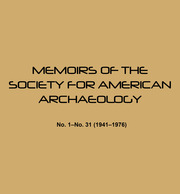Article contents
The Archaeological Evidence of Cultivated Wheat and Barley in Near Eastern Prehistory
Published online by Cambridge University Press: 27 June 2018
Extract
The data for this paper are taken from a larger manuscript study (Dyson, ms.) aimed at the collation of the specific evidence available at the present time on the first occurrences of the major traits of material culture in each sub-area of the Near East for the period from 5000 to 2500 B.C. Such a survey has not previously existed and it provides a solid reference work for checking on the exact locations of key items in the fields of agriculture, husbandry, textiles, metallurgy, transportation, and so on.
In making a survey of this nature the problem of chronology is paramount, for it is upon this basis that priority in discovery must be accredited to any one area, and that directions of diffusion must be determined. In this region, as in other parts of the world, the correlation of cultural events with Christian chronology has yet to be satisfactorily completed. We cannot, therefore, deal with any degree of accuracy in terms of particular years. The presence of stratigraphic deposits, however, does allow us to deal with periods of relative cultural time.
- Type
- Research Article
- Information
- Copyright
- Copyright © Society for American Archaeology 1953
References
1 Some authors use the diploid chromosome number for these series which is double the number given here.
2 Percival (in Caton-Thompson, 1934, p. 47) states that it is not known what changes occur in size and form of wheat grains during the process of carbonization, and, therefore, prefers to leave carbonized grain without final identification. On the other hand, Sir Rowland Biffen (in Brunton, 1937, p. 60) says that carbonization is due to the action of anaerobic bacteria causing the grain to become similar to T. vulgare Vill. in size and shape.
3 Caton-Thompson, 1934, p. 46; Brunton, 1937, pp. 33, 59; Vestal, 1936, p. 2; Mallowan, 1946, p. 128 and 1947, p. 12; Riis, 1948, pp. 205-7; Frankfort, 1933, p. 99; Marshall, 1931, p. 385; Piggot, 1950, p. 153.
4 Caton-Thompson, 1934, p. 46; Menghin, 1936, Vol. 2, p. 53 and App. V; Brunton, 1937, pp. 33, 59; Vestal, 1936, p. 2; Mallowan, 1946, p. 128 and 1947, p. 12; Kosay, 1944, pp. 186, 187; Osten, 1937, p. 333; Field, 1932, p. 307; Piggot, 1950, p. 153; Vats, 1940, p. 467.
5 For unidentified barley viz. Garstang, 1940, p. 75; Fitzgerald, 1935, p. 13; Mallowan, 1935, p. 15.
6 The cultural correlations and chronology used in this paper are based on those of Robert Braidwood, The Oriental Institute, University of Chicago, and Lauriston Ward, Harvard University.
- 1
- Cited by


